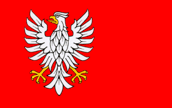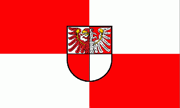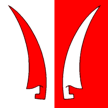Dictionary of Vexillology: D (Disc – Divisions) (original) (raw)
DISC (or DISK)
In vexillology a circular area of single colour used as a charge, and often (but not invariably) symbolic of the sun or a full moon (see also charge, crescent 1), hinomaru, ring 1) and sun emblem.
In heraldry, see roundel 3).
[ ![[Palau]](http://www.crwflags.com/fotw/images/v/vxt-d987.gif) ](../images/v/vxt-d987.gif) [
](../images/v/vxt-d987.gif) [ ![[example]](http://www.crwflags.com/fotw/images/v/vxt-d5135.gif) ](../images/v/vxt-d5135.gif) [
](../images/v/vxt-d5135.gif) [ ![[disc]](http://www.crwflags.com/fotw/images/v/vxt-d4548.gif) ](../images/v/vxt-d4548.gif)
](../images/v/vxt-d4548.gif)
National Flag of Palau; Roundel, Ukraine; Flag of the Christian-Democrat Party of East Timor
DISC (or DISK) VOIDED
[ ![[voided disk]](http://www.crwflags.com/fotw/images/v/vxt-d5312.gif) ](../images/v/vxt-d5312.gif) [
](../images/v/vxt-d5312.gif) [ ![[voided disk]](http://www.crwflags.com/fotw/images/v/vxt-d2870a.gif) ](../images/v/vxt-d2870a.gif) [
](../images/v/vxt-d2870a.gif) [ ![[voided disk]](http://www.crwflags.com/fotw/images/v/vxt-d2870.gif) ](../images/v/vxt-d2870.gif)
](../images/v/vxt-d2870.gif)
Flag of Grahamstown, South Africa; Arms and Flag of Ringerike, Norway
DISFIGURE
(v) To add any unauthorised charge, device or wording to the field of a flag, particularly when it is of an insulting or pejorative nature (see also ‘charge’, ‘desecrate’ and ‘device’ and compare with ‘deface’).
DISLODGING
In UK usage now obsolete, a term for the formal removal of a colour from the location at which it was housed and displayed during the relevant battalion’s temporary stay in any municipality (see also ‘lodging’ and ‘uncase(d) 1)’).
DISPLAYED
The heraldic term used when an eagle or other winged creature is shown with its wings elevated and sometimes inverted (see also ‘rising’, ‘vol’ and ‘volant’).
(adj) On flags the term may be used in place of flown, bourn or carried etc. – for example “a flag/pennant/banner was displayed above the ...”, or “the flagpole displayed a finial in the form of a ...”, or “the flag/pennant/banner displayed a charge ...”.



Flag of Brandenburg, Germany; Flag of Mazowieckie, Poland; Flag of Barnim, Germany
DISPLAYING A FLAG
See ‘Appendix II’.
DISPLAY MAST
See ‘sailor's mast’.
DISTAFF
The term for a spindle used in spinning that appears on several South European arms.
[ ![[distaff]](http://www.crwflags.com/fotw/images/v/vxt-d5275.gif) ](../images/v/vxt-d5275.gif) [
](../images/v/vxt-d5275.gif) [ ![[distaff]](http://www.crwflags.com/fotw/images/v/vxt-d5276.gif) ](../images/v/vxt-d5276.gif) [
](../images/v/vxt-d5276.gif) [ ![[distaff]](http://www.crwflags.com/fotw/images/v/vxt-d5277.gif) ](../images/v/vxt-d5277.gif)
](../images/v/vxt-d5277.gif)
Flag of Seixo de Gat�es, Portugal; Flag of Bico e Cristelo, Portugal; Flag of Ilha, Portugal
DISTANCE LINE
See ‘hoistline’ and its following note.
DISTINCTION JACK
See ‘privateer jack’.
[ ![[distinction jack]](http://www.crwflags.com/fotw/images/v/vxt-d1030.gif) ](../images/v/vxt-d1030.gif)
](../images/v/vxt-d1030.gif)
Distinction/Privateer Jack 1694–1801. England/UK
DISTINCTION OF COLOUR
In English then British RN usage now obsolete, the system of grading flag officers according to their seniority – see ‘blue ensign 2)’, ‘flag officer 2)’, ‘red ensign 2)’ and ‘white ensign 2)’ and their following notes (also ‘yellow admiral’).
[ ![[distinction of colour]](http://www.crwflags.com/fotw/images/v/vxt-d2383a.gif) ](../images/v/vxt-d2383a.gif) [
](../images/v/vxt-d2383a.gif) [ ![[distinction of colour]](http://www.crwflags.com/fotw/images/v/vxt-d2383b.gif) ](../images/v/vxt-d2383b.gif) [
](../images/v/vxt-d2383b.gif) [ ![[distinction of colour]](http://www.crwflags.com/fotw/images/v/vxt-d2383c.gif) ](../images/v/vxt-d2383c.gif)
](../images/v/vxt-d2383c.gif)
Command Flags of Flag Officers of the Red, White and Blue 1625–1702
Notes
a) This system was formally introduced in 1625, amended in 1653, extended in 1805 (the rank of Admiral of the Red was introduced following Trafalgar) and abolished in 1864.
b) Until the early 18th century however, these were not part of the naval rank structure, but were (rather) positions conferred by royal appointment to cover a specified campaign (although once an admiral always an admiral).
c) In 1653 the order of seniority was changed from red, blue and white to red, white then blue.
DISTINCTION PENDANT (or PENNANT)
- The term, now obsolete, for one of four triangular pennants used in Marryat’s 1817 Code of Signals for the Merchant Service, and raised at the head of a particular signal hoist to indicate which section of the signal book should be used to interpret the following flags – see Marryat’s code (also pendant, preparative, signal flag and the note following international code of signals).
- See pendant of distinction.
[ ![[distinction pendant]](http://www.crwflags.com/fotw/images/v/vxt-d157a.gif) ](../images/v/vxt-d157a.gif) [
](../images/v/vxt-d157a.gif) [ ![[distinction pendant]](http://www.crwflags.com/fotw/images/v/vxt-d157b.gif) ](../images/v/vxt-d157b.gif)
Distinction Pennants 1 and 3 in Marryat’s Code of Signals for the Merchant Service 1817–1857
](../images/v/vxt-d157b.gif)
Distinction Pennants 1 and 3 in Marryat’s Code of Signals for the Merchant Service 1817–1857
DISTINGUISHING FLAG
The flag of a civil position within a governmental structure, as opposed to that signifying military rank, as in for example, the distinguishing flag of a Government minister (see also ‘diplomatic flags’).
An alternative term for a rank flag (see also ‘rank flag’).
In US Air Force and Marine Corps usage, a flag denoting an officer's rank – see ‘individual flag’ (also ‘flag of command’, ‘personal flag 3)’ and ‘rank flag 1)’).
In US military usage, the flag of a command or organization not authorized to bear colours.
[ ![[distinguishing flags]](http://www.crwflags.com/fotw/images/v/vxt-d117.gif) ](../images/v/vxt-d117.gif) [
](../images/v/vxt-d117.gif) [ ![[distinguishing flags]](http://www.crwflags.com/fotw/images/v/vxt-d2106.gif) ](../images/v/vxt-d2106.gif) [
](../images/v/vxt-d2106.gif) [ ![[distinguishing flags]](http://www.crwflags.com/fotw/images/v/vxt-d5043.gif) ](../images/v/vxt-d5043.gif)
](../images/v/vxt-d5043.gif)
Minister of Defence, Argentina; Secretary for Defense US; Ministry of Extraordinary Situations, Russia
Please note, that although these terms are sometimes considered interchangeable, the Editors have drawn a general distinction between the command flags used by senior naval officers, the rank flags employed by officers from the other armed services, the distinguishing flags of civilians and with personal flags.
DISTINGUISHING JACK
- A newly introduced term for the jack (of a design which differs from its accompanying ensign) that is flown whilst a vessel is underway in order to distinguish that vessel’s special service or purpose, with an example in current use being the flag of a UK consular officer if flown as a jack � but see ‘colonial jack’, ‘government service jack’, under ‘jack’ and the notes below (also ‘diplomatic flags’, ‘jack’ and ‘jack staff’).
- A term which may also be used when the standard of a head of state (a royal or presidential standard) is flown from the jack staff of a naval launch when that head of state is aboard � but see ‘presidential standard(s) 1)’ and ‘royal standard(s) 1)’).
[ ![[distinguishing jack]](http://www.crwflags.com/fotw/images/v/vxt-d2330.gif) ](../images/v/vxt-d2330.gif) [
](../images/v/vxt-d2330.gif) [![[distinguishing jack]](http://www.crwflags.com/fotw/images/v/vxt-d2060.gif) ](../images/v/vxt-d2060.gif) [
](../images/v/vxt-d2060.gif) [ ![[distinguishing jack]](http://www.crwflags.com/fotw/images/v/vxt-d2347.gif) ](../images/v/vxt-d2347.gif)
](../images/v/vxt-d2347.gif)
Presidential Standard, Croatia;Consular Officer Afloat, UK;Royal Standard, Spain
Notes a) In Germany and Austria, Government (as well as civilian) vessels often fly the flag of the relevant state/province as a distinguishing jack. b) In some commonwealth countries the appropriate departmental flag is specified as a jack for government vessels. c) In UK usage now obsolete, the British Civil Air Ensign was flown as a jack by those tenders who serviced the flying boats of Imperial Airways (1924–1939).
[![[distinguishing jack]](http://www.crwflags.com/fotw/images/v/vxt-d2348.jpg) ](../images/v/vxt-d2348.jpg) [
](../images/v/vxt-d2348.jpg) [ ![[distinguishing jack]](http://www.crwflags.com/fotw/images/v/vxt-d2349.gif) ](../images/v/vxt-d2349.gif)
](../images/v/vxt-d2349.gif)
Short Empire Flying Boat c1938, UK (Wikipedia); Civil Air Ensign, UK
DISTINGUISHING (or DISTINCTIVE) MARK
Under the United Nations Convention on the Law of the Sea (UNCLOS), this is the mark that identifies a vessel's status as the warship or government owned ship of a sovereign state, and thus operated for non-commercial purposes (see also ‘suit of flags’).
[ ![[distinguishing flags]](http://www.crwflags.com/fotw/images/v/vxt-d1064.gif) ](../images/v/vxt-d1064.gif)
](../images/v/vxt-d1064.gif)
A Stealth Warship of the Royal Norwegian Navy Flying the Distinguishing Marks of Ensign, Jack and Masthead Pennant
Please note that this distinguishing mark is invariably the ship's ensign, to lesser extent the masthead pennant and in some cases also the jack (see also 'ensign' 'jack' ‘masthead pennant 1)’) and ‘suit of flags’).
DISTINGUISHING PLATE
See ‘rank plate’.
[ ![[distinguishing plate]](http://www.crwflags.com/fotw/images/v/vxt-d1033.gif) ](../images/v/vxt-d1033.gif)
](../images/v/vxt-d1033.gif)
Distinguishing/Rank Plate of a Vice Admiral RN, UK
DISTINGUISHING VANE (PENDANT or PENNANT)
In British RN and some other naval usage now obsolete, the alternative terms for a short triangular pennant or large rectangular flag of different coloured panels, often stiffened with a frame and sometimes flown (in addition to a masthead pennant) by sailing warships to indicate (depending upon the masthead employed) the division of a fleet to which they belonged or to identify individual ships within that division (see also ‘frame 2)’, ‘masthead’ and ‘masthead pennant 1)’).
DIVER BELOW (or DIVER DOWN) FLAG
Flag A (Alpha or Alfa) in the International Code of Signals, signifying that the vessel flying the flag has a diver down and that vessels approaching should keep well clear and proceed at slow speed (see also ‘International Code of Signal Flags’ and ‘signal flag’).
In US and some other usage, a red flag with a white descending diagonal stripe indicating that divers are below the surface in the immediate vicinity of the flag.
[ ![[diver below flags]](http://www.crwflags.com/fotw/images/v/vxt-d119.gif) ](../images/v/vxt-d119.gif) [
](../images/v/vxt-d119.gif) [ ![[diver below flags]](http://www.crwflags.com/fotw/images/v/vxt-d119a.gif) ](../images/v/vxt-d119a.gif)
](../images/v/vxt-d119a.gif)
Signal Flag Alpha; Unofficial Warning Flag
Please note however, that while often referred to as unofficial, use of 2) is required by law in most US states, and by law or regulation in some other countries.
DIVERGING STRIPES
See ‘expanding stripes’.
[ ![[diverging stripes example]](http://www.crwflags.com/fotw/images/v/vxt-d599.gif) ](../images/v/vxt-d599.gif)
](../images/v/vxt-d599.gif)
Flag of Zeewolde, Netherlands
DIVIDED
In vexillology see ‘bicolour’, ‘multi-stripe’, ‘triband’ and ‘tricolour’.
In heraldry see ‘party’.
[ ![[divided example]](http://www.crwflags.com/fotw/images/v/vxt-d1943.gif) ](../images/v/vxt-d1943.gif) [
](../images/v/vxt-d1943.gif) [ ![[divided example]](http://www.crwflags.com/fotw/images/v/vxt-d1942.gif) ](../images/v/vxt-d1942.gif) [
](../images/v/vxt-d1942.gif) [ ![[divided example]](http://www.crwflags.com/fotw/images/v/vxt-d1944.gif) ](../images/v/vxt-d1944.gif)
](../images/v/vxt-d1944.gif)
Aboriginal Flag, Australia; National Flag, Uganda; Civil Flag and Ensign, Belgium
DIVINE RATIO (or PROPORTIONS)
See ‘golden mean’.
[ ![[divided example]](http://www.crwflags.com/fotw/images/v/vxt-d3388.gif) ](../images/v/vxt-d3388.gif)
](../images/v/vxt-d3388.gif)
National Flag of Togo in the golden mean/divine ratio
DIVISIONS IN HERALDRY
A phrase used to describe the boundaries between two fields on a shield, banner of arms or a flag – lines of partition – but see the note below and dancetty, embattled, embowed,indented, nebuly and serrated (also flanches andstepped).
[ ![[division example]](http://www.crwflags.com/fotw/images/v/vxt-d4432.gif) ](../images/v/vxt-d4432.gif) [
](../images/v/vxt-d4432.gif) [ ![[division example]](http://www.crwflags.com/fotw/images/v/vxt-d740a.gif) ](../images/v/vxt-d740a.gif) [
](../images/v/vxt-d740a.gif) [ ![[division example]](http://www.crwflags.com/fotw/images/v/vxt-d4431.gif) ](../images/v/vxt-d4431.gif)
](../images/v/vxt-d4431.gif)
Flag of Groesbeek, The Netherlands; Flag of Seftigen, Switzerland; National Flag of Bahrain
Please note that the above phrase does not refer to the dividing of a shield or flag into two or more straight-sided sections as illustrated below – see impaled quartered.


Flag of Sugnens, Switzerland; House Flag of Freitas Martins, Portugal